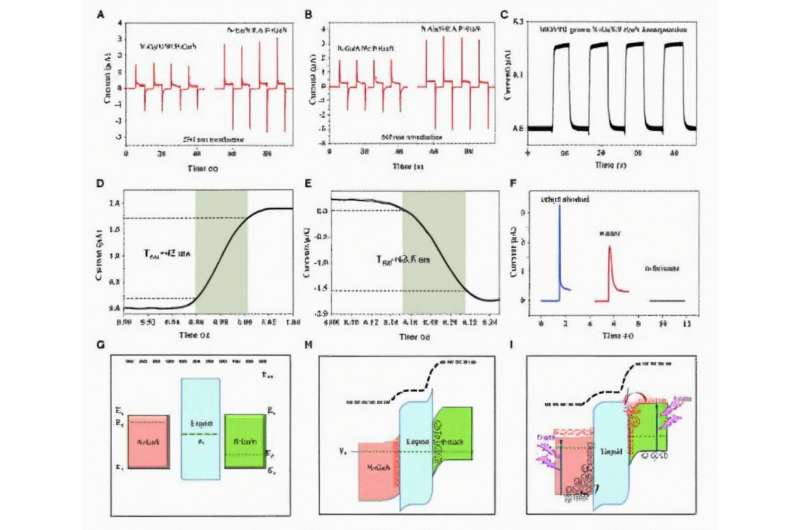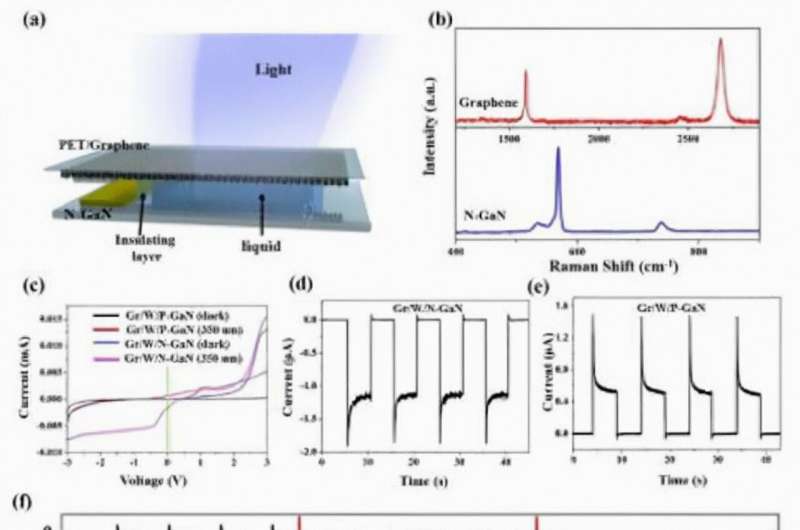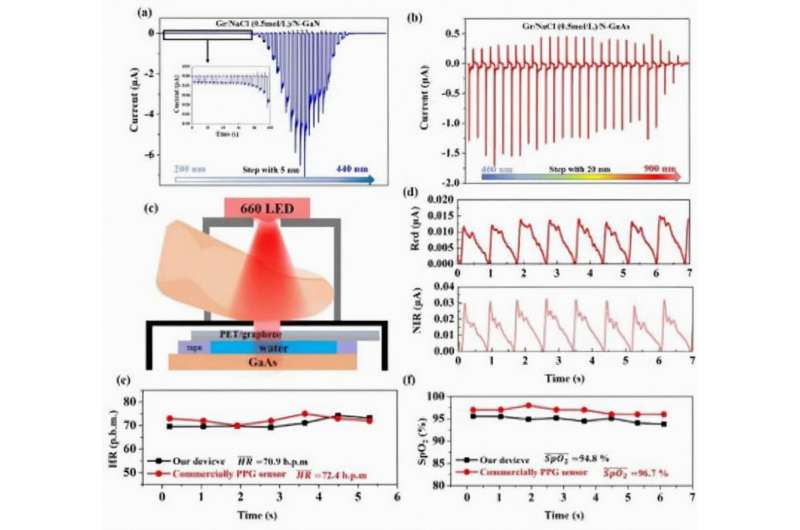This article has been reviewed according to Science X's editorial process and policies. Editors have highlighted the following attributes while ensuring the content's credibility:
fact-checked
peer-reviewed publication
proofread
A liquid water-molecule-based graphene heterogeneous photodetector and its application in an oximeter

In the context of the development of smart health care towards digitalization, the new generation of photodetectors has a wide range of application prospects and huge market value. The characteristics of graphene material, such as large carrier mobility, excellent optical transparency and high mechanical strength, make it a favorite for the development of new generation photodetectors.
Most photodetectors use solid semiconductors and rarely use liquid as the sensing unit, and the traditional heterogeneous or homogeneous PN junction photodetector preparation equipment is expensive and complicated, such as the need for advanced vacuum epitaxy equipment such as metal-organic chemical vapor deposition (MOCVD), molecular beam epitaxy (MBE), and the growth process corresponding to these devices on semiconductor PN junction has a very strict material lattice match.
The growth processes corresponding to these devices have very strict requirements on the material lattice matching of semiconductor PN junctions, which limits the choice of semiconductors needed for the detection of different light sources. In addition, photo-excited carriers require an applied bias voltage as an applied driver to collect the carriers, which additionally increases the cost and energy consumption of the driver circuits.
To solve this problem, Professor Shisheng Lin's team at Zhejiang University reported a novel graphene photodetector based on polarized liquids such as water molecules. After the polar liquid is in contact with the N-type semiconductor and graphene, due to the difference between the Fermi energy level and the chemical potential of the polar liquid, the polar liquid at the interface will be polarized and the corresponding charge will be induced at the solid-liquid two-phase interface.
Under the irradiation of an external light source, a large number of hole-electron pairs are generated in the semiconductor, and these photogenerated carriers gather on both sides of the polar liquid and output a transient photopolarization current.

Under continuous irradiation from an external light source, more polar liquid molecules are polarized by the new photogenerated carriers gathered on both sides, which induces the water molecules to rotate in an orderly manner and generates a stable photopolarization current, and the increase of the photopolarization current is further achieved by introducing ionic solutions.
Moreover, the work proposes a novel device physics for liquid-based photodetectors, which utilizes the flexibility and high conductivity of graphene to achieve a stable and high-precision noninvasive human oxygen monitoring function based on liquid photodetectors. The results were published in Research as "Self-driven photo-polarized water molecule triggered graphene-based photodetector."
The physical framework of dynamic diode originally proposed by Prof. Shisheng Lin's group in 2018 (Authorized National Invention Patent: CN201810739256.2, Authorized U.S. Invention Patent: US Patent 11,522,468), this time the original use of rapid mechanical rotation of water molecules, developed self-driven photodetectors using molecular scales for polar liquid-based. These photodetectors effectively avoid the need for lattice matching and achieve good detection performance from the deep ultraviolet to the near infrared.
Compared with the new photodetectors, the all-solid-state devices have photogenerated carriers instantaneously separated by the built-in electric field after the incident light excitation, and no transient photopolarization current occurs. And due to the different Fermi energy levels and chemical potentials, Gr/W/N-GaN and Gr/W/P-GaN exhibit different directional photocurrent outputs. Under the excitation of light, a large number of photogenerated carriers drift toward the interface, polarizing the water molecules.
Utilizing a salt solution of the polar liquid instead of deionized water further improves the photocurrent by increasing the conductivity of the intermediate polar liquid. The authors next investigated the dependence of the device with optical power and the device noise. The results show that at low frequencies the device is dominated by 1/f noise, while the device exhibits good photoconversion stability and optical power dependence characteristics.

The present work provides a potential way to break through the limitation of lattice matching of heterojunction semiconductor photodetectors by freely selecting a suitable semiconductor in combination with a polar liquid according to the wavelength to be detected. In this work, GaAs with broadband absorption is integrated into a photoconversion measurement device to successfully detect visible and near-infrared wavelengths.
The authors have successfully extracted the AC and DC components of the signal from the photovolumetric pulse wave, where the AC component is mainly derived from the light absorbed by the detector through the blood flowing through the arteries, which is a direct reflection of the change in vessel diameter.
A stable noninvasive human oximetry monitoring function based on polar molecular liquid polarization photodetectors was finally achieved, with heart rate and oxygen saturation obtained at 69.7-74.2 beats per minute and 93.8-95.6%, respectively, which are very close to those obtained by commercial oximeters at the same time.
The present study reveals liquid-based high-performance UV photodetectors, where insertion of a polar liquid into a PN junction can generate a persistent photopolarization current under light illumination.
Under light illumination, the photogenerated electrons and holes will continuously move toward the solid-liquid interface due to the difference in chemical potentials of polarizers and semiconductor Fermi energy levels, which provides a new idea to solve the problem of the detector being limited by the lattice-matching constraints and the arbitrarily adjustable detection wavelength.
In future research, the researchers will focus on designing flexible wearable health monitoring devices for important additions. They also seek to solve the various problems currently limiting the lattice matching of heterojunction detectors and to provide various critical information for non-invasive health assessment of the human body through optoelectronic monitoring devices.
More information: Shisheng Lin et al, Self-Driven Photo-Polarized Water Molecule-Triggered Graphene-Based Photodetector, Research (2023). DOI: 10.34133/research.0202
Journal information: Research
Provided by Research



















